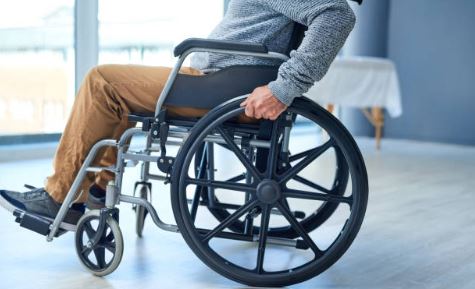
Paralysis/Stroke is a serious neuromuscular disease involving the brain. If it is not treated in time, it can lead to permanent disability in the patients. When there is a malfunction in the right side of the brain, the limbs and face on the left side are affected, and when there is a malfunction in the left side of the brain, the limbs and face on the right side are affected and the body droops.
पक्षाघात हा मेंदूसंबंधी एक गंभीर असा न्यूरोमस्क्युलर आजार आहे. यावर वेळीच उपचार न केल्यास रुग्णांमध्ये कायमचं अपंगत्वही येऊ शकते. उजव्या बाजूच्या मेंदूमध्ये जेंव्हा बिघाड होतो तेंव्हा डाव्या बाजूच्या हात-पाय आणि चेहऱ्यावर परिणाम होतो आणि डाव्या बाजूच्या मेंदूमध्ये जेंव्हा बिघाड होतो तेंव्हा उजव्या बाजूच्या हात-पाय आणि चेहऱ्यावर परिणाम होतो व शरीर लुळे पडते.
Proper blood supply to the brain is necessary for the proper functioning of the brain. If the brain does not have proper blood supply, paralysis occurs due to which the strength in the arms and legs of the patient decreases. Here information about what is paralysis, causes of paralysis, why and what causes paralysis, symptoms and treatment of paralysis is given in this article.
मेंदूचे कार्य सुरळीतणे चालण्यासाठी मेंदूला रक्तपुरवठा व्यवस्थित होणे गरजेचे असते. मेंदूला योग्यप्रकारे रक्तपुरवठा न झाल्यास पक्षाघात (पॅरालिसीस) होतो त्यामुळे रुग्णाच्या हाता-पायातील ताकद कमी होते. याठिकाणी पक्षाघात म्हणजे काय, पक्षाघाताची कारणे, पक्षाघात का व कशामुळे होतो, पक्षाघात लक्षणे आणि उपचार याविषयी माहिती ह्या लेखामध्ये दिली आहे.
पक्षाघाताचे प्रकार : पक्षाघाताचे दोन प्रमुख प्रकार असतात.
Types of Paralysis: There are two main types of paralysis.
1) Ischemic stroke (Ischemic पक्षाघात) :-
In this type, a blood clot forms in the blood vessels of the brain, which cuts off the blood supply to a particular part of the brain, leading to paralysis.
या प्रकारात मेंदुतील रक्तवाहिन्यांमध्ये रक्ताची गाठ तयार होते त्यामुळे मेंदूच्या विशिष्ट भागास रक्ताचा पुरवठा बंद झाल्यामुळे पक्षाघात होतो.
2) Hemorrhagic paralysis (Hemorrhagic पक्षाघात) :-
In this type, blood vessels in the brain burst and bleed into the brain, leading to paralysis. After a stroke, a CT scan or MRI scan is used to determine the type of stroke before treatment.
या प्रकारात मेंदुमधील रक्तवाहिन्या फुटून मेंदूत रक्तस्त्राव होऊन पक्षाघात होतो. पक्षाघाताचा झटका आल्यावर सीटी स्कॅन किंवा एमआरआय स्कॅनद्वारे कोणता प्रकार आहे ते उपचार करण्यापूर्वी तपासले जाते.
3) Transient Ischemic Attack (क्षणिक इस्केमिक हल्ला) :-
There is also a third type called TIA. In this, the symptoms of paralysis disappear within 24 hours and the patient recovers completely. But TIA is a warning. Once a TIA occurs, you are more likely to have a subsequent stroke if not treated properly. Then even if TIA comes and goes, the doctor should get diagnosis and treatment. This will help in avoiding the risk of stroke.
TIA नावाचा एक तिसरा प्रकारही असतो. यामध्ये पक्षाघाताची लक्षणे 24 तासाच्या आत निघून जातात आणि रुग्ण पूर्ववत बरा होतो. मात्र TIA ही Warning असते. एकदा TIA येऊन गेल्यास योग्य उपचार न केल्यास आपणास पुढे पक्षाघाताचा झटका येण्याची शक्यता अधिक असते. तेंव्हा TIA येऊन गेल्याससुध्दा डॉक्टरांकडून निदान आणि उपचार करून घ्यावेत. त्यामुळे पक्षाघाताचा धोका टळण्यास मदत होईल.
Symptoms of Paralysis: पक्षाघाताची लक्षणे :
The brain does not receive proper blood supply due to a cut off of blood supply to the brain or bleeding in the brain. Due to this, the following symptoms of paralysis appear due to the adverse effect on the brain function.
◼️ The strength of the arms and legs on one side decreases.
◼️ Numbness in hands and feet, tingling.
◼️ The mouth becomes crooked, it is difficult to speak.
◼️ Difficulty swallowing food and breathing.
◼️ Blurred vision in one eye.
◼️ Dizziness, loss of balance,
◼️ Loss of consciousness
◼️ Severe headache
These symptoms are present in paralysis. If such symptoms are experienced, immediate medical treatment is required.
मेंदूचा रक्त पुरवठा बंद झाल्यामुळे किंवा मेंदूमध्ये रक्तस्त्राव झाल्यामुळे मेंदूला योग्यरित्या रक्तपुरवठा होत नाही. त्यामुळे मेंदूच्या कार्यावर विपरीत परिणाम होऊन खालील पक्षाघाताची लक्षणे दिसून येतात.
◼️ एका बाजूच्या हाता-पायाची ताकद कमी होते.
◼️ हातापायात लुळेपणा जाणवतो, मुंग्या येतात.
◼️ तोंड वाकडं होते, बोलण्यास त्रास होतो.
◼️ अन्न गिळण्यास आणि श्वास घेण्यास त्रास होतो.
◼️ एका डोळ्याने अंधुक दिसू लागणे.
◼️ चक्कर येणे, तोल जाणे,
◼️ चेतना कमी होणे
◼️ तीव्र डोकेदूखी
ही लक्षणे पक्षाघातात असतात. अशी लक्षणे जाणवल्यास त्वरीत वैद्यकीय उपचार होणे आवश्यक असते.

लक्षात ठेवा ‘FAST’ (Remember ‘FAST’)
Remember ‘FAST’ to recognize stroke symptoms.
F – Face (Facial Weakness): Ask the patient to smile. If one side of the face, lips and eyes droop when smiling, it is a sign of paralysis.
A – Arms (Arm Weakness): Ask the patient to lift both his arms forward and up. If the patient cannot lift one arm up and forward, it is a sign of paralysis.
S – Speech Difficulty) : Ask the patient questions and see if he speaks properly. If he has trouble speaking, it is a sign of paralysis.
T – Time (Time to Act) :
Abnormalities occur when performing an action or reacting without the normal response
पक्षाघाताची लक्षणे ओळखण्यासाठी ‘FAST’ लक्षात ठेवा..
F – Face (Facial Weakness) : रुग्णास हसण्यास सांगा. हसताना एका बाजूचा चेहरा, ओठ आणि डोळे लटकलेले दिसल्यास ते पक्षाघाताचे लक्षण असते.
A – Arms (Arm Weakness) : रुग्णाला त्याचे दोन्ही हात पुढे व वर उचलण्यास सांगा. जर रुग्णाचा एक हात वर व समोर उचलता येत नसल्यास ते पक्षाघाताचे लक्षण असते.
S – Speech Difficulty) : रुग्णास प्रश्न विचारून तो व्यवस्थित बोलतो का ते पहा. जर त्याला बोलताना त्रास होत असल्यास ते पक्षाघाताचे लक्षण असते.
T – Time (Time to Act) :
कोणतीही कृती करताना किंवा प्रतिक्रिया देताना सामान्य प्रतिक्रिया न आढळता त्यामध्ये विसंगती आढळते